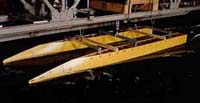|
-MARIN-test-jets.jpg) Since the early 90's, AMD has been carrying out an on going catamaran R&D program, with emphasis on hull resistance, seakeeping and structure.
The seakeeping program alone was described by MARIN as the most extensive of its type that they had undertaken for a client. Since the early 90's, AMD has been carrying out an on going catamaran R&D program, with emphasis on hull resistance, seakeeping and structure.
The seakeeping program alone was described by MARIN as the most extensive of its type that they had undertaken for a client.
As a result of this programme, AMD can offer customers a seakeeping, powering and structural design performance which is a
generation ahead of the competition.
SEAKEEPING
 AMD’s second generation wave piercing hull form has been rigorously
tested and optimised through a series of tank tests at the Maritime Research
Institute Netherlands (MARIN). A series of 4 metre long self propelled
models were tested in a variety of irregular sea spectrums with wave heights
of up to 5 metres. The resulting optimized hull shape demonstrated that the AMD
second generation hull form has better seakeeping ability and lower vertical
accelerations than competitors vessels, and the test data gathered is
used to conduct seakeeping feasibility studies for ferry operators. AMD’s second generation wave piercing hull form has been rigorously
tested and optimised through a series of tank tests at the Maritime Research
Institute Netherlands (MARIN). A series of 4 metre long self propelled
models were tested in a variety of irregular sea spectrums with wave heights
of up to 5 metres. The resulting optimized hull shape demonstrated that the AMD
second generation hull form has better seakeeping ability and lower vertical
accelerations than competitors vessels, and the test data gathered is
used to conduct seakeeping feasibility studies for ferry operators.
RESISTANCE
 AMD has tested numerous hull forms and hull form variations in a systematic
tank test program. As well as resistance, wash heights have been measured,
and the resistance effects of shallow water, keel and chine rocker, transom immersion,
round bilges, trim tabs and bow thrusters have been investigated. The
AMD resistance data base includes high and very high speed waterjet propelled
hulls, propeller driven hulls, small planing catamarans, air lubricated
catamarans and large high speed car carrying catamarans with speeds up
to 60 knots. Resistance data from these tank tests has been supplemented
by wind tunnel testing undertaken to determine both the wind resistance
of the above water structure and the wind forces during slow speed manoeuvring.
From these exhaustive tests AMD is able to select an optimum hull form
to match the carrying capacity and speed requirement of a particular project,
providing a vessel which is superior to vessels of similar size, speed
and capacity. AMD has tested numerous hull forms and hull form variations in a systematic
tank test program. As well as resistance, wash heights have been measured,
and the resistance effects of shallow water, keel and chine rocker, transom immersion,
round bilges, trim tabs and bow thrusters have been investigated. The
AMD resistance data base includes high and very high speed waterjet propelled
hulls, propeller driven hulls, small planing catamarans, air lubricated
catamarans and large high speed car carrying catamarans with speeds up
to 60 knots. Resistance data from these tank tests has been supplemented
by wind tunnel testing undertaken to determine both the wind resistance
of the above water structure and the wind forces during slow speed manoeuvring.
From these exhaustive tests AMD is able to select an optimum hull form
to match the carrying capacity and speed requirement of a particular project,
providing a vessel which is superior to vessels of similar size, speed
and capacity.
STRUCTURE
 Fatigue cracking of aluminium structures would appear to be a normal operational
expectation in much of the high speed vessel industry. This is not the
case with AMD vessels. Highly developed design procedures and sophisticated
analysis techniques such as the latest 3D finite element analysis methods
and panel vibration assessment, combined with AMD’s in service experience,
enables a much more thorough fatigue analysis to be carried out, maximising
the confidence in the reliability of the vessel structure. Fatigue cracking of aluminium structures would appear to be a normal operational
expectation in much of the high speed vessel industry. This is not the
case with AMD vessels. Highly developed design procedures and sophisticated
analysis techniques such as the latest 3D finite element analysis methods
and panel vibration assessment, combined with AMD’s in service experience,
enables a much more thorough fatigue analysis to be carried out, maximising
the confidence in the reliability of the vessel structure.
NOISE & VIBRATION
Several studies have been undertaken into the area of noise and vibration
in an effort to improve noise level predictions in the early stages of
design development, giving increased confidence in structural reliability
and passenger comfort.
RIDE CONTROL SYSTEMS
Studies undertaken into the area of ride control systems provide accurate
predictions of the increased seakeeping abilities offered by ride control.
Ride control systems that are used on AMD vessels include active trim
tabs, T-foils, fixed foils and combinations of these systems.
|





